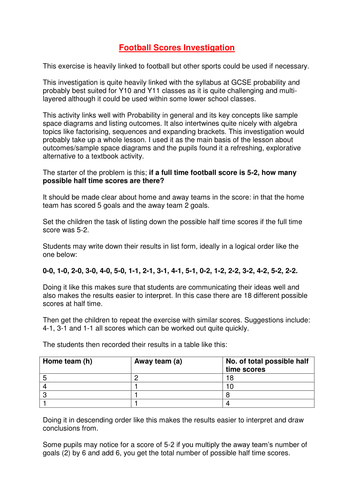

This is an investigation (including teacher notes and worksheets) which is suitable for GCSE maths students, though higher ability KS3 students should be able to complete it.
The problem students have to answer is ‘Can you find a formula to find out the total possible number of half-time scores if you know the full-time score of a football match?’ Probability is the main topic covered (listing outcomes, formula for total number of outcomes) as well as algebra topics such as expanding brackets, sequences, factorising and generalising formulae.
Pupils can probably work on this independently with some teacher input in setting up the investigation and prompting pupils.
Get this resource as part of a bundle and save up to 73%
A bundle is a package of resources grouped together to teach a particular topic, or a series of lessons, in one place.
Huge Set of KS3/GCSE Maths Foundation Whole Lessons and Investigations
A bundle which consists of 6 Powerpoints (on Constructing/Solving Linear Equations, Writing Equations and Formulae, Working out the Interior and Exterior Angles of a Polygon, Recognising and Drawing Nets of 3-D Shapes, Sample Space Diagrams and Standard Form). Each Powerpoint contains enough material for a whole lesson and has plenty of questions and worked examples.
Huge Set of KS3/GCSE Maths Investigations
A set of 6 investigations (complete with teacher notes and worksheets) where students are set a challenging problem and work to find the solution. Each investigation should take up a whole lesson. The first investigation focuses mainly on probability and gets pupils to find the total possible number of half-time scores if given the full-time score, eventually finding a formula connecting the two. The second connects geometry and algebra, getting pupils to generate a formula which links the total possible number of triangles with a given perimeter. The third investigation gets pupils to discover the origins of square numbers whilst the fourth gets students to calculate the optimum rate (using compound interest) at which interest should be added to money in order to achieve maximum interest. The bundle concludes with a pair of investigations on triangular numbers, the first helping pupils to appreciate the properties of the sequence and the second which gets pupils to discover the derivation for the nth term of the triangular number sequence.
Something went wrong, please try again later.
Report this resourceto let us know if it violates our terms and conditions.
Our customer service team will review your report and will be in touch.